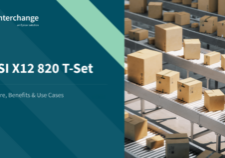EDI 214 T-Set: Structure, Benefits & Use Cases
The American National Standards Institute X12 (ANSI X12) plays a pivotal role in Electronic Data Interchange (EDI), providing the framework for seamless and efficient business-to-business (B2B) communication in the logistics industry.
This article focuses on the ANSI X12 EDI 214 transaction set (T-set), a crucial component for businesses requiring accurate and timely shipment status updates. Understanding the significance, structure, and strategic application of the EDI 214 T-set is essential for companies looking to optimise their supply chain operations.
From outlining its core benefits to navigating its intricacies, we aim to explore this T-set comprehensively, ensuring businesses can fully leverage their potential.
Suggested reading: Bookmark our explainer of the ANSI X12 standard for more information on its various T-Sets and applications.
What is the ANSI X12 EDI 214 T-Set?
The EDI 214 T-Set is a standardised electronic document defined by the American National Standards Institute (ANSI) X12 committee. It’s designed to convey detailed shipment status information between trading partners in the logistics industry.
As a carrier shipment status message, the EDI 214 provides real-time updates on the location, condition, and estimated delivery time of goods in transit. This transaction set is pivotal in enhancing visibility and efficiency throughout shipping.
The EDI 214 T-Set facilitates seamless communication between shippers, carriers, and recipients, helping reduce errors, minimise delays, and improve overall supply chain performance.
Everyday use cases for the EDI 214 T-Set
The versatility of the EDI 214 T-Set makes it invaluable across various industries. In retail, for instance, it enables precise tracking of inventory movements from distribution centres to stores.
Manufacturing firms rely on EDI 214 to monitor the arrival of critical components, ensuring just-in-time production schedules are maintained. A car parts manufacturer in Birmingham once averted a costly production shutdown using EDI 214 to track a delayed shipment and adjust their assembly line accordingly.
Third-party logistics companies leverage this transaction set to give their clients real-time visibility into shipment statuses. This transparency helps build trust and improve customer satisfaction.
Trucking companies use EDI 214 to communicate with shippers and receivers, providing up-to-date information on pickup times, transit progress, and delivery estimates. This level of detail enhances operational efficiency and allows for better resource allocation.
Example of an EDI 214 T-Set
To better understand the structure of an EDI 214 T-Set, let’s examine a typical message:
| ST*214*0001 B10*4567890123*ABCD*20240715 L11*1234567*PO N1*SH*ACME WIDGETS LTD N1*CN*GLOBAL SHIPPING CO LX*1 AT7*X6*NS*20240715*1000 MS1*LONDON*UK*12345 AT8*G*L*12345.6*KG L11*TRUCK123*Equipment ID |
Now, let’s break down the key segments and their meanings:
| Segment | Example | Description |
| ST | ST2140001 | Transaction Set Header: Indicates the start of the transaction set with identifier code 214 (Transportation Carrier Shipment Status Message) and control number 0001. |
| B10 | B104567890123ABCD*20240715 | Beginning Segment for Transportation Carrier Shipment Status: Provides shipment identification number 4567890123, carrier’s SCAC code ABCD, and shipment date 20240715. |
| L11 | L111234567PO | Reference Identification: Specifies additional reference number 1234567 related to the shipment, with the qualifier PO (Purchase Order Number). |
| N1 | N1SHACME WIDGETS LTD | Name: Identifies the shipper with the code SH, which is ACME WIDGETS LTD. |
| N1 | N1CNGLOBAL SHIPPING CO | Name: Identifies the consignee with the code CN, which is GLOBAL SHIPPING CO. |
| LX | LX*1 | Assigned Number: Indicates the start of a new logical group of data segments with assigned number 1. |
| AT7 | AT7X6NS202407151000 | Shipment Status Details: Provides specific information about the shipment’s current status with status code X6, reason code NS, status date 20240715, and status time 1000. |
| MS1 | MS1LONDONUK*12345 | Equipment, Shipment, or Item Detail: Gives location information related to the shipment, indicating the location is LONDON, country code is UK, and postal code is 12345. |
| AT8 | AT8GL12345.6KG | Shipment Weight, Packaging, and Quantity Data: Indicates the gross weight (G) of the shipment is 12345.6 kilograms (KG). |
| L11 | L11TRUCK123Equipment ID | Business Instructions and Reference Number: Specifies the equipment identification TRUCK123 with the qualifier Equipment ID. |
How is the EDI 214 T-Set processed?
The processing of the ANSI X12 EDI 214 T-Set involves several steps, from the initial generation of the shipment status update to the final integration and action by the recipient. Understanding this workflow helps ensure all parties can effectively manage and respond to shipment status updates. Below is a detailed breakdown of the typical workflow:
- Event triggering: The process begins when a significant event or status change occurs in the shipment’s journey. This could be pickup, departure, arrival at a waypoint, customs clearance, or final delivery.
- Data collection: The transportation carrier collects relevant shipment status data. This includes identifying numbers such as bill of lading or shipment ID, SCAC codes for carrier identification, detailed location information, timestamps, and any other pertinent details about the shipment’s current status.
- EDI 214 preparation: The collected data is formatted into an EDI 214 document according to ANSI X12 standards. This includes filling out all required segments, such as the shipment header, status details, and location information.
- Transmission: Once the EDI 214 document is prepared, it is transmitted to the relevant trading partners (e.g., shippers, consignees, or third-party logistics providers) through secure EDI communication protocols. This ensures the integrity and confidentiality of the data during transmission.
- Receipt and validation: Upon receipt, the recipient’s EDI system validates the document to ensure it is complete and conforms to the required standards. This step helps identify any errors or discrepancies that need to be addressed.
- Integration: After validation, the shipment status data from the EDI 214 document is integrated into the recipient’s internal systems, such as transportation management systems, warehouse management systems, or customer-facing tracking applications.
- Action and response: Based on the status information, recipients can take necessary actions such as updating estimated arrival times, adjusting downstream logistics plans, or notifying customers of delays or early deliveries. If there are any issues or discrepancies, the recipient may send a response or acknowledgement to the sender.
- Analysis and reporting: The data from EDI 214 transactions can be aggregated and analysed to evaluate carrier performance, optimise routing decisions, and improve overall supply chain efficiency.
This automated process offers several key benefits:
- Real-time visibility: EDI 214 enables near real-time tracking of shipments, allowing businesses to proactively manage their supply chains and respond swiftly to any issues that may arise.
- Improved accuracy: EDI 214 reduces errors by eliminating manual data entry and ensures consistent, high-quality data across systems.
- Enhanced efficiency: Automation speeds up information flow, allowing quicker decision-making and more responsive customer service.
- Better resource planning: Accurate status updates enable businesses to optimise resource allocation, from warehouse space to staff scheduling.
- Increased customer satisfaction: Providing timely and accurate shipment status information can significantly enhance customer trust and satisfaction.
However, implementing EDI 214 can present some challenges:
- EDI standards compliance: Ensuring compliance with EDI standards across different trading partner relationships can be complex.
- Proper use of reason codes: Accurately representing shipment statuses using the correct reason codes requires attention to detail and thorough training.
- System integration: Integrating EDI 214 data with existing systems may require significant IT resources and expertise.
- Data quality management: Maintaining consistent, high-quality data across all EDI 214 transactions is crucial but challenging, especially when dealing with multiple carriers or trading partners.
To overcome these challenges and maximise the benefits of EDI 214, consider the following best practices:
- Collaborate closely with trading partners: Establish clear communication protocols and data requirements with all parties involved in the EDI 214 exchange.
- Invest in robust EDI software: Choose EDI solutions that offer strong validation features, easy integration with existing systems, and comprehensive support.
- Provide thorough training: Ensure that all staff involved in EDI 214 processes are well-trained in the transaction set’s technical aspects and business implications.
- Regularly audit and optimise: Continuously monitor EDI 214 processes for accuracy and efficiency, and be prepared to make adjustments as needed.
- Consider working with EDI experts: Partnering with experienced EDI service providers can help ensure smooth implementation and ongoing optimisation of your EDI 214 processes.
By following these steps and best practices, businesses can leverage EDI 214’s full potential to enhance their supply chain visibility, improve operational efficiency, and ultimately deliver better service to their customers.
What are the equivalents of the EDI 214 T-Set in other standards?
While EDI 214 is widely used, particularly in North America, other regions and industries may use different standards for similar purposes. Here’s a comparison of EDI 214 equivalents in other common EDI standards:
| EDI Standard | Equivalent of EDI 214 |
| EDIFACT | IFTSTA (International Multimodal Status Report) |
| TRADACOMS | DELIVAC (Delivery Confirmation) |
| VDA | VDA 4987 (Status Message) |
| ODETTE | AVIEXP (Despatch Advice) |
Streamlining your supply chain with ANSI X12 EDI 214
From retail giants to manufacturing powerhouses, the EDI 214 T-Set provides a robust framework for managing shipment statuses and maintaining real-time visibility. Its adoption facilitates better inventory management, optimises logistics operations, and ensures stakeholders are always informed about the location and condition of their goods.
As technology evolves, so does the application of EDI 214. Emerging trends include integrating IoT devices for more granular shipment data and AI-powered analysis for predictive insights. These advancements, guided by ongoing refinements from the Data Interchange Standards Association, promise to enhance the power of EDI 214 further.
Understanding the structure, processing, and future direction of EDI 214, along with its equivalents in other standards, equips businesses to operate seamlessly across platforms and borders. This adaptability is crucial in today’s global market, where efficient data exchange can be a key differentiator.
Ready to enhance your supply chain operations and gain real-time shipment visibility with the ANSI X12 EDI 214 T-Set? Contact our EDI experts today to get started and unlock the full potential of your EDI capabilities.



























































































































